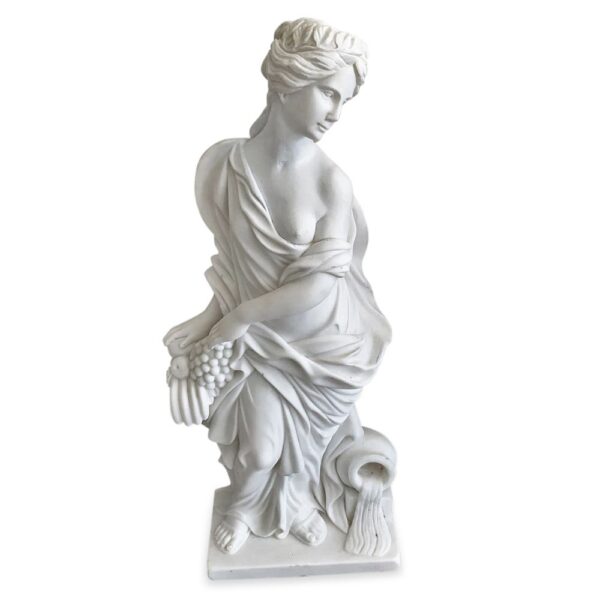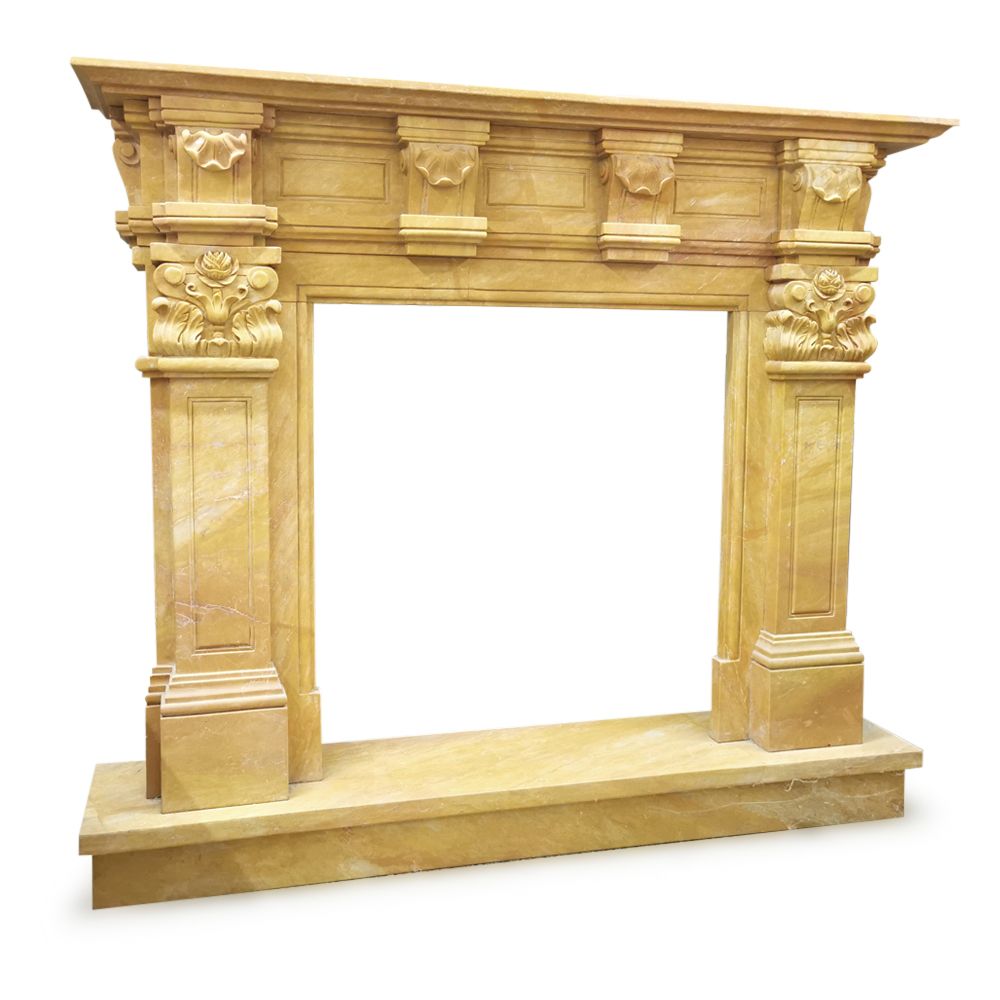Classic Egyptian Yellow Marble Fireplace L 150cm
€4.900,00 €3.430,00
- Width 150cm, Height 120cm, Depth 30cm. Weight about 150 kg. Shipping weight 250 kg.
- The frame is also suitable for gas or flame simulation devices.
- Made in Italy. Any imperfections and differences from the image are to be considered a guarantee of uniqueness.
- Refined fireplace frame made of fine yellow Egyptian marble. This unique piece, with its natural beauty and craftsmanship, represents the perfect blend of art and functionality.
- Fireplace frame, made and carved from Egyptian yellow marble. The Louis XVI style decorations, which evoke classical themes with floral motifs, make it a perfect complement for settings with a classic taste.
- The combination with the dark and precious woods of antique furniture will enhance the elegance of the entire environment while, in minimal contexts with a contemporary design, it will be able to confer an undisputed touch of classic elegance and enhance, by contrast, the clean lines and shapes.
- Yellow Egyptian marble is renowned for its warm, golden hue, which immediately lends a sense of luxury and welcome to any room. Each vein and shade tells a story thousands of years old, making each setting unique.
SYMBOLOGY.
The fireplace has a rich symbolism that has developed over the centuries, reflecting its cultural and functional importance in human habitation. Since ancient times, the fireplace has been more than just a means of heating the home; it has been a symbol of family, safety, and domesticity. The fireplace represents warmth, both literal and metaphorical. On cold winter nights, the fireplace fire provides a refuge from the cold, creating a cozy and safe environment. This physical warmth extends to a sense of protection and emotional comfort, making the fireplace a symbol of safety and well-being. It is the place where the family gathers, where stories are shared and moments are spent together. This central role in domestic life makes it a symbol of family unity and cohesion. Welcoming guests next to the fireplace represents the pinnacle of hospitality and generosity. The fireplace, therefore, also symbolizes openness and sharing, fundamental values in human relationships. Fire itself, the heart of the fireplace, is a symbol of transformation. The process of burning wood to create heat is seen as a metaphor for change and purification. Fire transforms wood into ashes, but in doing so, it produces light and warmth, symbolizing the ability to turn difficulties into opportunities and to find light even in the darkest situations. The fireplace also evokes a sense of tradition and continuity. The fireplace also evokes a sense of tradition and continuity. In many cultures, the fireplace fire is kept burning as a symbol of family continuity and connection to the past. It is a reminder of past generations who found warmth and protection beside the fire and a sign of the continuous passage of time and traditions from one generation to the next. In many traditions, fire also has a spiritual dimension. It is seen as a means of communicating with the divine, purifying the soul, and celebrating sacred rituals. The fireplace, therefore, can also be seen as a sacred place, a domestic altar where fire symbolizes the presence of the sacred in daily life.
In many traditions, fire also has a spiritual dimension. It is seen as a means to communicate with the divine, to purify the soul and to celebrate sacred rituals. The fireplace, therefore, can also be seen as a sacred place, a domestic altar where fire symbolizes the presence of the sacred in daily life.
THE PROCESSING
The Louis XVI style, which predates by a few years the reign of Louis XVI from whom it takes its name, marks a significant turning point in the landscape of art and design. This style represents the transition from the redundant and bizarre forms of Rococo to the more sober and disciplined Neoclassicism. The common thread of this movement is the reference to classical culture, both Greek and Roman. The return to classical models brings with it a predilection for composure of form and symmetrical decoration, aspects that characterize the aesthetics of the period. Decorative elements become more sober, orderly, and regular, in sharp contrast to the abundance and decorative excess of Rococo. This new sobriety gives objects and furnishings an appearance of refinement and harmony, making the Louis XVI style synonymous with high quality workmanship and elegance. Even today, the Louis XVI style is appreciated for its ability to combine the timeless elegance of classical culture with precision craftsmanship of the highest standard. Clean lines and balanced forms reflect an attention to detail and a quest for perfection that continue to influence contemporary design. To choose furniture or decorative elements inspired by this style is to opt for beauty that transcends passing fads, embodying values of quality, balance and harmony.
THE MATERIAL.
 Yellow Egyptian marble is a fine and fascinating material, often chosen to add a touch of elegance and luxury to various architectural and interior design elements. With its characteristic golden hue and distinctive veining, this marble is highly prized for both its aesthetic appearance and its inherent qualities. The color of Egyptian yellow marble is a warm and welcoming shade of golden yellow, making it particularly attractive. This color is reminiscent of sunlight and can help create a warm and inviting atmosphere in any room. The natural veining found in marble adds depth and character, making each piece unique and one-of-a-kind. In terms of physical properties, Egyptian yellow marble is known for its strength and durability. It is a sturdy material that can withstand daily wear and tear, keeping its beauty intact over time. This durability makes it ideal for applications such as fireplace surrounds, floors, wall coverings, and other surfaces that require a durable material. In addition, Egyptian yellow marble is relatively easy to maintain. With regular cleaning and maintenance, you can preserve its luster and shine for many years. It is stain and scratch resistant, features that make it a practical option for home environments. Another significant benefit of Egyptian yellow marble is its ability to add value to a property. The use of fine materials such as this can elevate the overall aesthetic of a home, making it more attractive and, potentially, increasing its market value. The timeless appeal of marble is always appreciated, and an item such as an Egyptian yellow marble fireplace surround can become a focal point in any room, attracting attention and inspiring admiration. Finally, the craftsmanship of Egyptian yellow marble adds another layer of value. The master craftsmen who carve and finish this marble work with great care and precision, creating pieces that are true works of art. Every detail is carefully considered, ensuring that the final product is not only functional, but also aesthetically sublime. Yellow Egyptian marble is an excellent choice for those seeking a material that combines beauty, durability and prestige. Whether for a fireplace surround, floor or wall cladding, this marble offers a touch of luxury that can transform any space into an elegant and refined environment.
Yellow Egyptian marble is a fine and fascinating material, often chosen to add a touch of elegance and luxury to various architectural and interior design elements. With its characteristic golden hue and distinctive veining, this marble is highly prized for both its aesthetic appearance and its inherent qualities. The color of Egyptian yellow marble is a warm and welcoming shade of golden yellow, making it particularly attractive. This color is reminiscent of sunlight and can help create a warm and inviting atmosphere in any room. The natural veining found in marble adds depth and character, making each piece unique and one-of-a-kind. In terms of physical properties, Egyptian yellow marble is known for its strength and durability. It is a sturdy material that can withstand daily wear and tear, keeping its beauty intact over time. This durability makes it ideal for applications such as fireplace surrounds, floors, wall coverings, and other surfaces that require a durable material. In addition, Egyptian yellow marble is relatively easy to maintain. With regular cleaning and maintenance, you can preserve its luster and shine for many years. It is stain and scratch resistant, features that make it a practical option for home environments. Another significant benefit of Egyptian yellow marble is its ability to add value to a property. The use of fine materials such as this can elevate the overall aesthetic of a home, making it more attractive and, potentially, increasing its market value. The timeless appeal of marble is always appreciated, and an item such as an Egyptian yellow marble fireplace surround can become a focal point in any room, attracting attention and inspiring admiration. Finally, the craftsmanship of Egyptian yellow marble adds another layer of value. The master craftsmen who carve and finish this marble work with great care and precision, creating pieces that are true works of art. Every detail is carefully considered, ensuring that the final product is not only functional, but also aesthetically sublime. Yellow Egyptian marble is an excellent choice for those seeking a material that combines beauty, durability and prestige. Whether for a fireplace surround, floor or wall cladding, this marble offers a touch of luxury that can transform any space into an elegant and refined environment.
The fireplace, history and tradition.
| Weight | 250 kg |
|---|---|
| Dimensions | 30 × 150 × 120 cm |
| Offerta | 30% |

 Italiano
Italiano

















